Unanticipated miracles happen every summer in the quiet paradise of Estonia's seaside capital. The first this year came as a total surprise. Having got off the afternoon coach from Riga last Monday and dumped bags at my villa base in Pärnu's garden zone, I headed back into town for the first event.
Leonskaja was in town to play the Grieg Piano Concerto in the first of the EFO's two annual Pärnu concerts. But she eagerly embraced chamber-musical opportunities with true colleagues including unsurpassable clarinettist and EFO lynchpin Matthew Hunt; they had already played and swum together, as they did here, at Prussia Cove (the two pictured below). 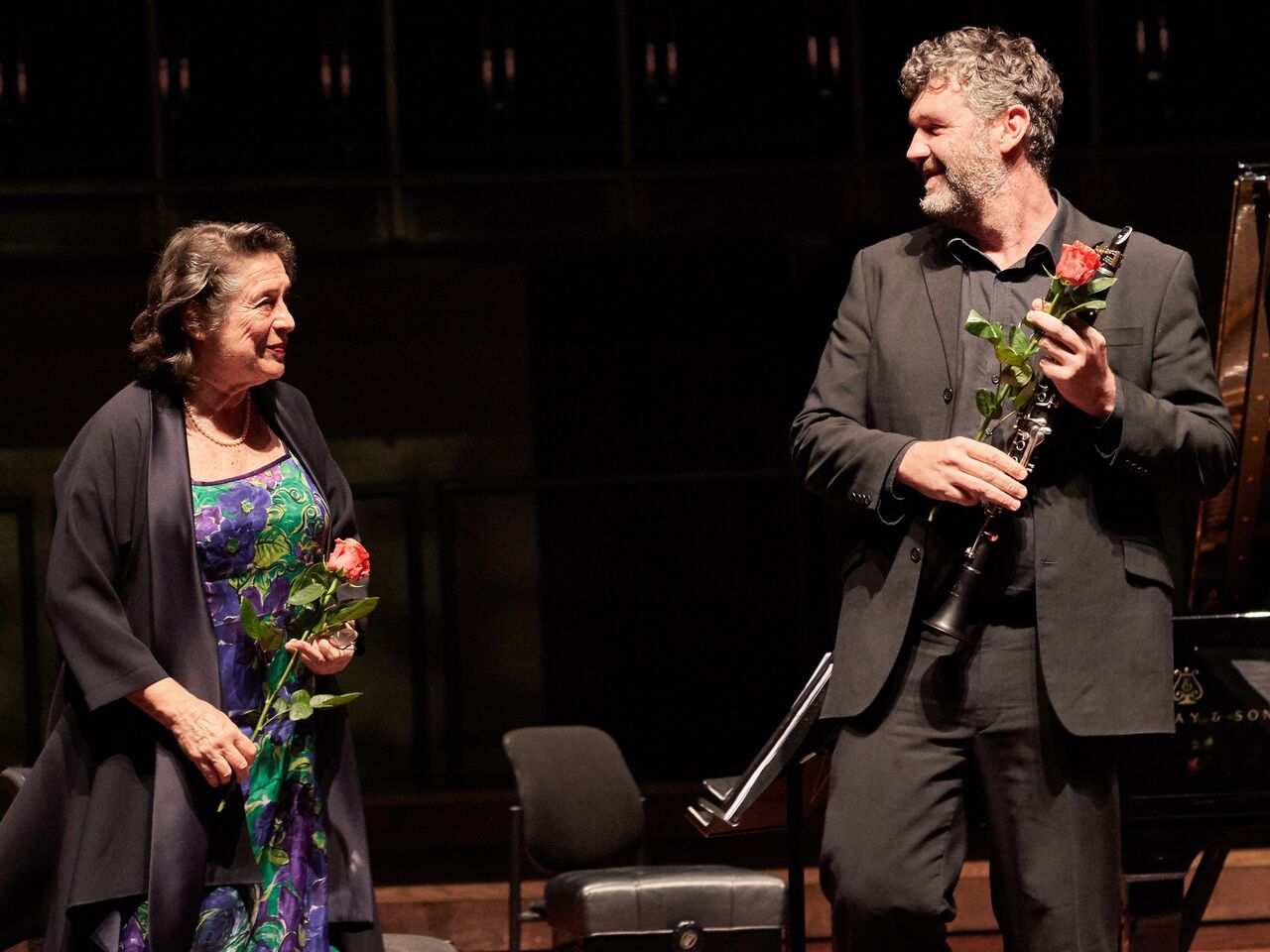 Leonskaja wanted breadth and elevation, especially in the slow movement, where the phrases were stretched to heavenly infinity. Hunt and equals SCO principal horn Alec Frank-Gemmill, oboist José Luis Garcia Vegara and bassoonist Jesús Villa Ordóñez worked hard at Leonskaja's smiling, iron-fist-in-velvet-glove behest; the results were levitational. EFO star violinist and principal of the Estonian National Symphony Orchestra Triin Ruubel, too far advanced in pregnancy to join the tour this year, later told me it was simply the most perfect performance of anything she'd ever heard, so much so that she slipped out after hearing it.
Leonskaja wanted breadth and elevation, especially in the slow movement, where the phrases were stretched to heavenly infinity. Hunt and equals SCO principal horn Alec Frank-Gemmill, oboist José Luis Garcia Vegara and bassoonist Jesús Villa Ordóñez worked hard at Leonskaja's smiling, iron-fist-in-velvet-glove behest; the results were levitational. EFO star violinist and principal of the Estonian National Symphony Orchestra Triin Ruubel, too far advanced in pregnancy to join the tour this year, later told me it was simply the most perfect performance of anything she'd ever heard, so much so that she slipped out after hearing it.
Ruubel herself (pictured below with fellow violinist Adela-Maria Bratu and Leonskaja) shone in two more perfect chamber performances. Festival administrator, programmer and former bassoonist in the orchestra Tea Tuhkur had convinced Leonskaja to learn the complex piano part of the 1935 Piano Quintet by troubled Estonian composer Eduard Oja. Bold in its ideas from the start, confident in lyrical string writing (Oja was a fine violinist), it only just missed total-masterpiece status with an over-extended return of earlier material just before the end. 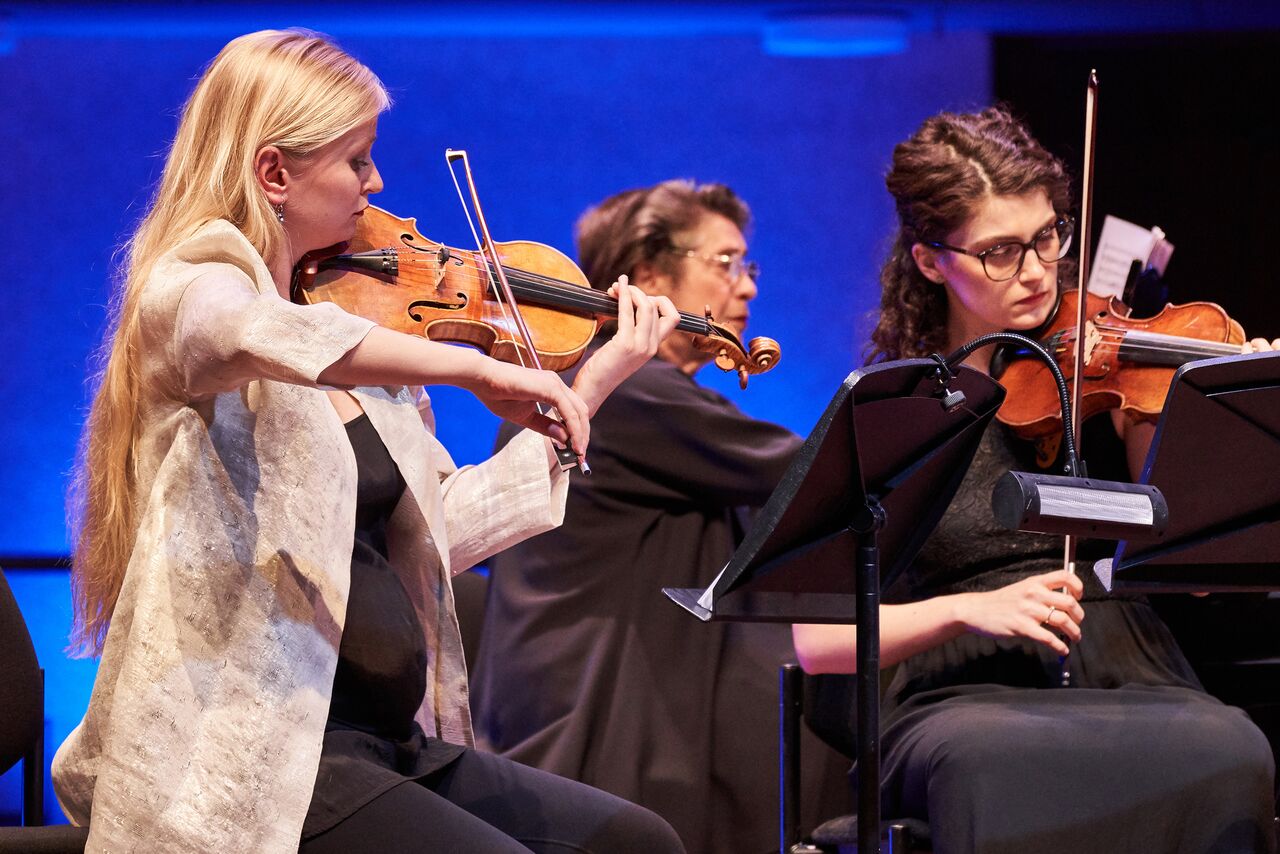 The Quintet crowned the now-habitual evening of purely Estonian music. Everything was compellingly done, especially so top viola-player Mari Adachi's exquisitely modulated solo in special native spirit Tõnu Kõrvits' Wanderer's Song (Kõrvits later received a special award at the first orchestral concert). Resident artist-photographer Kaupo Kikkas marvelled at how Adachi had "got" the folk intonations in the work; she told me she thought there was much in common between Estonian and Japanese traditional idioms.
The Quintet crowned the now-habitual evening of purely Estonian music. Everything was compellingly done, especially so top viola-player Mari Adachi's exquisitely modulated solo in special native spirit Tõnu Kõrvits' Wanderer's Song (Kõrvits later received a special award at the first orchestral concert). Resident artist-photographer Kaupo Kikkas marvelled at how Adachi had "got" the folk intonations in the work; she told me she thought there was much in common between Estonian and Japanese traditional idioms.
Another much-loved Estonian composer, Veljo Tormis, figured in an Electro-Folk event later that evening masterminded by Kristjan, the wild-card brother of Paavo and flautist Maarika Järvi. Scheduled for the concert-hall roof, it was kept indoors by technical issues. An audience far removed from the usual crossover crowd seemed to resist, as I did, the trance-y connections of KJ’s own compositions to Glass and Max Richter. Nor did feted Estonian jazz pianist Kristjan Randalu get enough of a look in. But there was true creativity from the two female vocalists, Liisi Koikson and the spectacularly versatile Kadri Voorand (pictured below), especially when their Tormis songs found haunting harmonic support from the two electric guitarists. 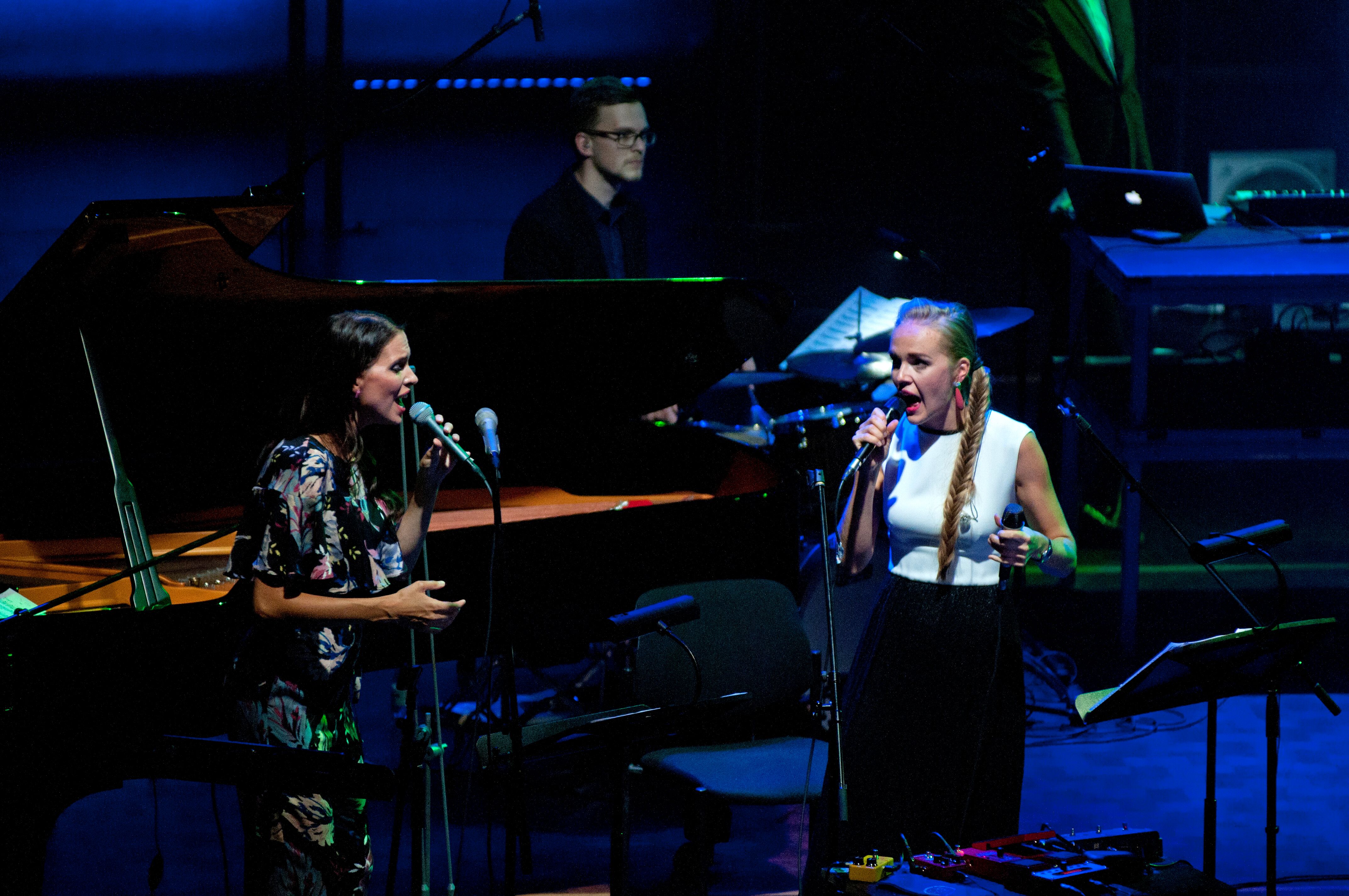 All events other than a very charming children's concert from Estonian early-music group Kiili in the art nouveau Villa Ammende were held in the concert hall, a Järvi-backed wonder for a town-sized place like Pärnu. Here the players spent all day rehearsing, some of them also participating in the conducting course tied to the Järvi Academy where patriarch Neeme Järvi, his eldest son and Leonid Grin, Paavo's first conducting mentor, offered dedicated guidance. While a festival visitor may spend the daytime moving from beach to cafe and arrive fresh for the evening's spectaculars, the musicians rarely see the sea other than to participate in one of Kikkas's amusing photo-shoots (this year's horn section pictured below).
All events other than a very charming children's concert from Estonian early-music group Kiili in the art nouveau Villa Ammende were held in the concert hall, a Järvi-backed wonder for a town-sized place like Pärnu. Here the players spent all day rehearsing, some of them also participating in the conducting course tied to the Järvi Academy where patriarch Neeme Järvi, his eldest son and Leonid Grin, Paavo's first conducting mentor, offered dedicated guidance. While a festival visitor may spend the daytime moving from beach to cafe and arrive fresh for the evening's spectaculars, the musicians rarely see the sea other than to participate in one of Kikkas's amusing photo-shoots (this year's horn section pictured below). 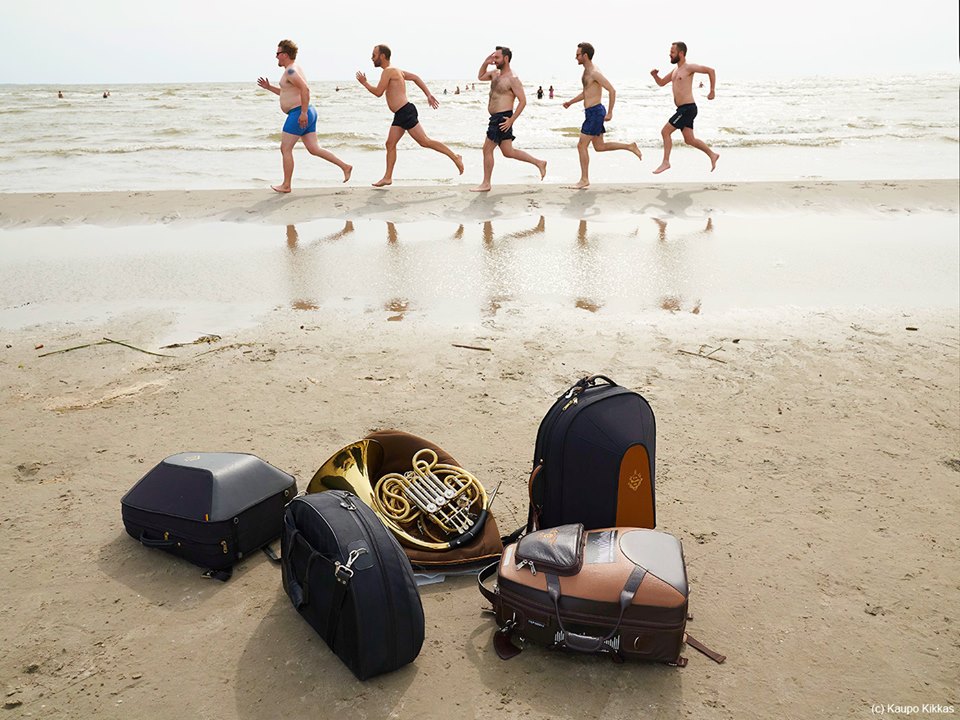 Rehearsals are worth attending if you can tear yourself away from Pärnu’s outdoor charms. Sprightly soon-to-be-83-year-old Arvo Pärt arrived one lunchtime from Tallinn to get involved with Paavo Järvi and the EFO's rehearsal of his Third Symphony (1971). Neeme conducted the Gothenburg Symphony Orchestra in this work at the Proms back in 1989, an event which led to my first momentous visit to Estonia when it was still part of the Soviet Union (my first Pärnu experience 26 later revealed what democracy and the European dream can really do for a small, young nation determined to succeed).
Rehearsals are worth attending if you can tear yourself away from Pärnu’s outdoor charms. Sprightly soon-to-be-83-year-old Arvo Pärt arrived one lunchtime from Tallinn to get involved with Paavo Järvi and the EFO's rehearsal of his Third Symphony (1971). Neeme conducted the Gothenburg Symphony Orchestra in this work at the Proms back in 1989, an event which led to my first momentous visit to Estonia when it was still part of the Soviet Union (my first Pärnu experience 26 later revealed what democracy and the European dream can really do for a small, young nation determined to succeed).
Järvi junior’s interpretation of this unique symphonic statement – variations on a single religious chant – went very deep indeed; hear for yourselves in the Prom. It stood in austere contrast to the tumultuous premiere of much younger Estonian composer Jüri Reinvere’s "...And tired from happiness". Dazzlingly orchestrated, stupendously well-played, it would suit the Albert Hall well (pictured below: Paavo Järvi holding up the score).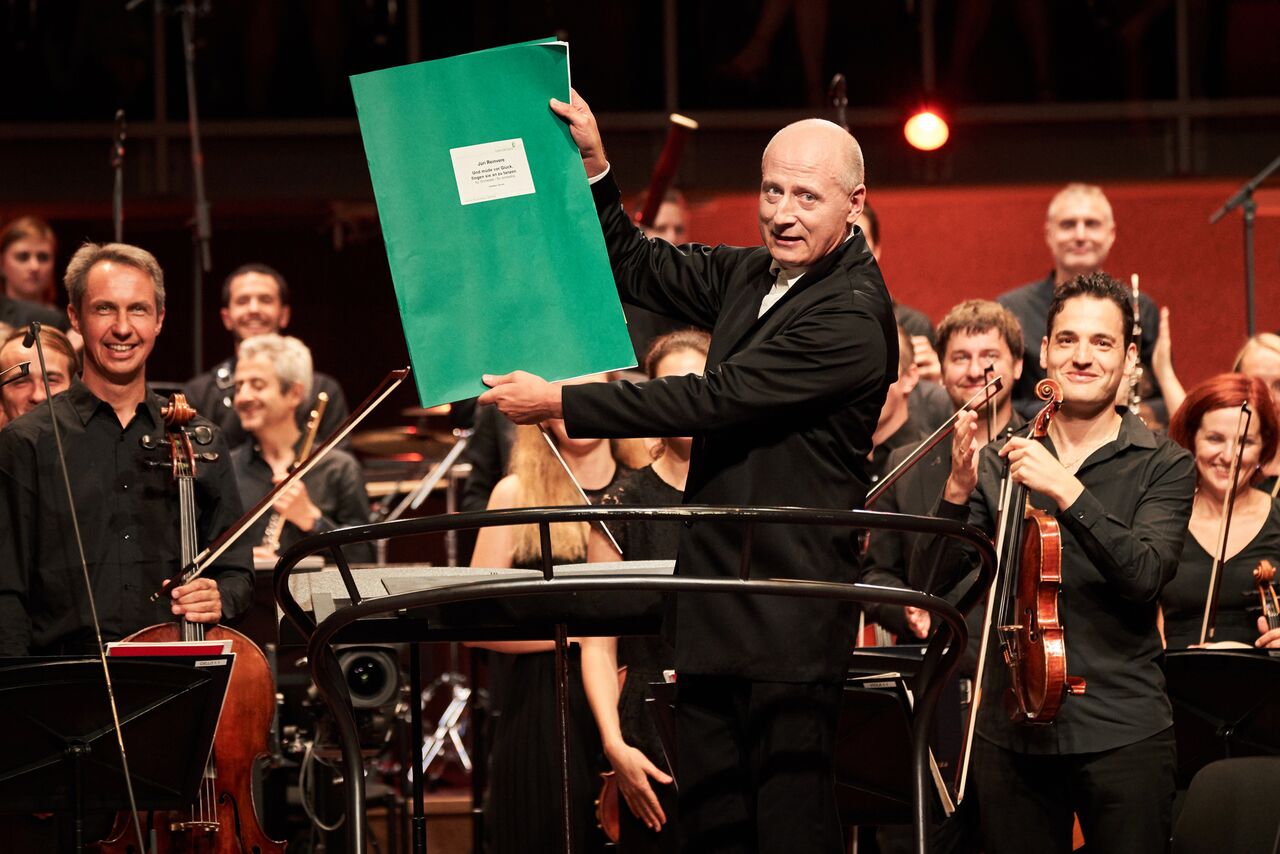 Leonskaja’s Grieg was revelatory: newly phrased, conceived and spaced, but without soloistic tricks and manners and if not note-perfect, a lesson in re-creative musicianship. Ravel’s La Valse brought the house crashing down in high style; keeping the woozy-loving parody of the early stages flexible is one thing, but sustaining the violence once it all starts to go seriously wrong is another, and the burning intensity held here. A pity that the smaller forces coming to London prevent this being the obvious encore, though Järvi has a regular stock of showpieces on which to draw, and London won’t have heard some of them.
Leonskaja’s Grieg was revelatory: newly phrased, conceived and spaced, but without soloistic tricks and manners and if not note-perfect, a lesson in re-creative musicianship. Ravel’s La Valse brought the house crashing down in high style; keeping the woozy-loving parody of the early stages flexible is one thing, but sustaining the violence once it all starts to go seriously wrong is another, and the burning intensity held here. A pity that the smaller forces coming to London prevent this being the obvious encore, though Järvi has a regular stock of showpieces on which to draw, and London won’t have heard some of them.
There was more peerless Ravel in the annual chamber showcase for the EFO “army of generals”. If there’s a richer rainbow of colours and dynamics to be drawn from the harp than the vivacious Jana Boušková, principal harpist of the Czech Philharmonic, gave us in the Introduction and Allegro, I’ve never heard it (pictured below - the septet of performers). 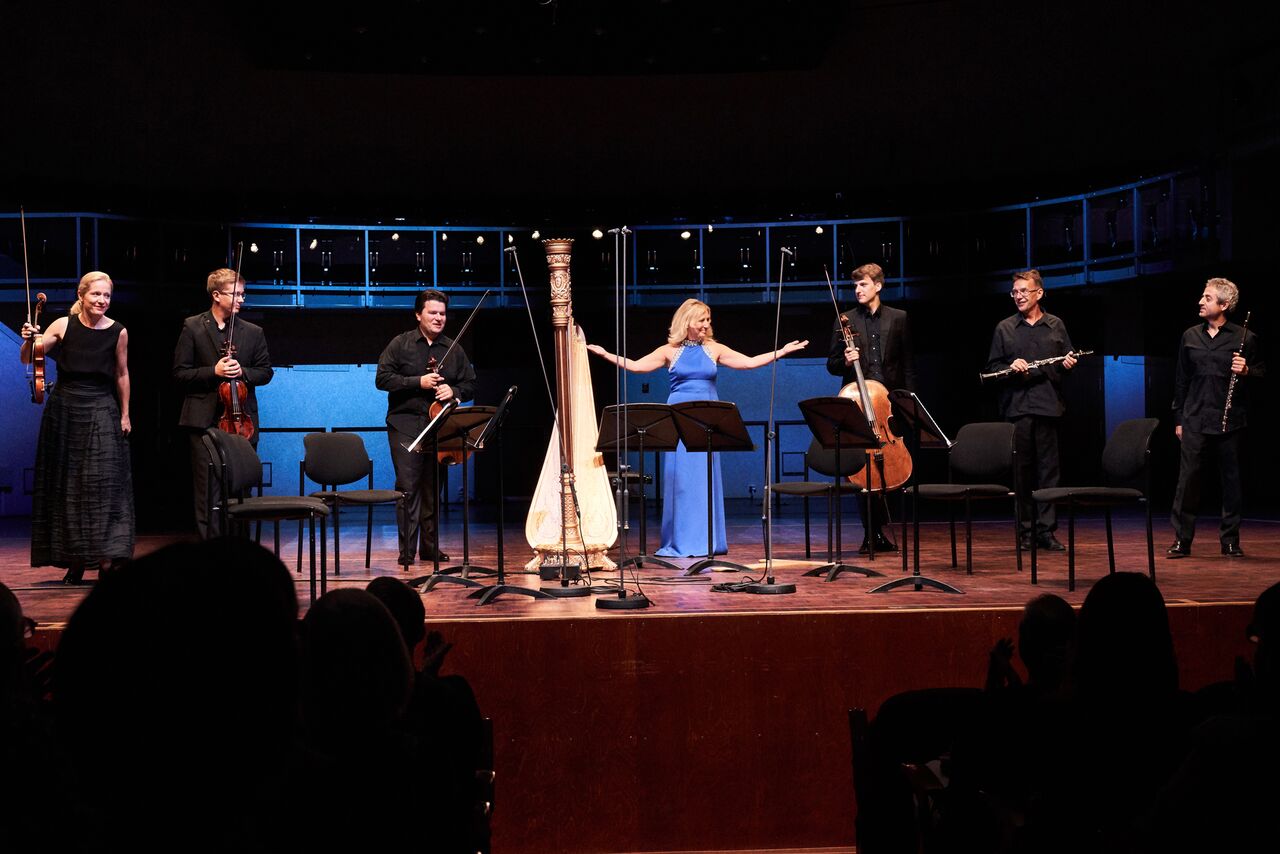 The first half of the evening was beautifully programmed by Pärnu Music Festival chief Kristjan Hallik and Tuhkur, cannily matching younger Estonians with more experienced international figures in Shostakovich’s Two Pieces for String Octet – ferocious stuff to perform on your night off – and among the eight cellos (EFO section leader Georgi Anichenko and seven Estonians) of Pärt’s Silouans Song. Eights framed the threes of Casterède's delicious musiquette Flûtes en vacances and the Serenade for two violins and viola of Kodály, who never seems to have produced a routine work. The ultimate elevation came from Hunt, Ruubel, Emma Yoon, Nathan Braude and Anichenko in Brahms’s Clarinet Quintet. The infinitely free but still focused interpretation proved that there is no end to the painful depths in this masterpiece; I’ll be steering clear of other lives performances for the foreseeable future.
The first half of the evening was beautifully programmed by Pärnu Music Festival chief Kristjan Hallik and Tuhkur, cannily matching younger Estonians with more experienced international figures in Shostakovich’s Two Pieces for String Octet – ferocious stuff to perform on your night off – and among the eight cellos (EFO section leader Georgi Anichenko and seven Estonians) of Pärt’s Silouans Song. Eights framed the threes of Casterède's delicious musiquette Flûtes en vacances and the Serenade for two violins and viola of Kodály, who never seems to have produced a routine work. The ultimate elevation came from Hunt, Ruubel, Emma Yoon, Nathan Braude and Anichenko in Brahms’s Clarinet Quintet. The infinitely free but still focused interpretation proved that there is no end to the painful depths in this masterpiece; I’ll be steering clear of other lives performances for the foreseeable future.
The conducting students shared the Academy limelight in another unusual programme: the completion of Eduard Tubin’s last orchestral movement by Kaljo Raid as the Eleventh Symphony, given the right swinging rhythmic energy under Alexander Zemtsov; Arutanian's lively and unashamedly demotic Trumpet Concerto brilliantly articulated by EFO and Russian National Orchestra first trumpeter Vladislav Lavrik; and another Estonian joint work, Tobias’s Walpurgis-Burleske orchestrated by Tubin and conducted here by Artūrs Gailis, before six others - three women, three men - shared Tchaikovsky’s Third Symphony. The most experienced was EFO violinist Sergej Bolkhovets, who made a blazing case for the Third’s tricky finale (and no cuts à la Temirkanov). 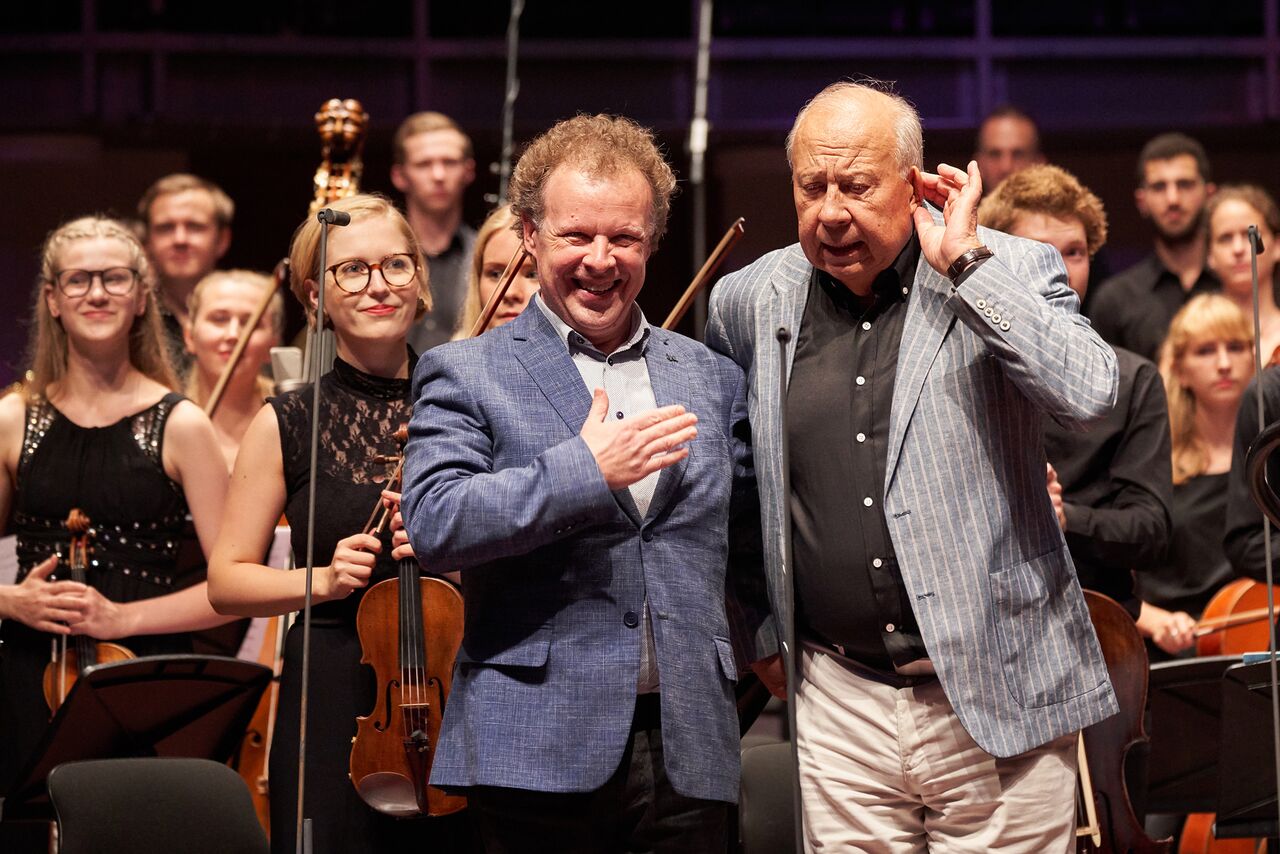 We also got a brief taste of Järvi senior’s undiminished panache conducting the young Estonians in a prizewinning entry by Urmas Lattikas for Estonia 100’s march competition, before generously handing the baton to the composer (the two pictured above).
We also got a brief taste of Järvi senior’s undiminished panache conducting the young Estonians in a prizewinning entry by Urmas Lattikas for Estonia 100’s march competition, before generously handing the baton to the composer (the two pictured above).
The last concert truly crowned the week, starting with the vibrant tension of Lutosławski's Concerto for Orchestra, a coruscating masterpiece which has probably never opened a concert before; would that its spider web of sound, catching nursery tunes in a queasy textural weave and showcasing these superlative players to perfection, could be heard in London, too. Violinist Midori will be the star name when the orchestra tours Japan; her slightly old-fashioned virtuoso intensity, with closed eyes and ferocious concentration suggesting a privately inhabited world, was not unresponsive to the seething orchestra around her in the Sibelius Violin Concerto, and Järvi, masterly with all soloists in a way that’s rare among conductors, kept perfect tabs (pictured below). 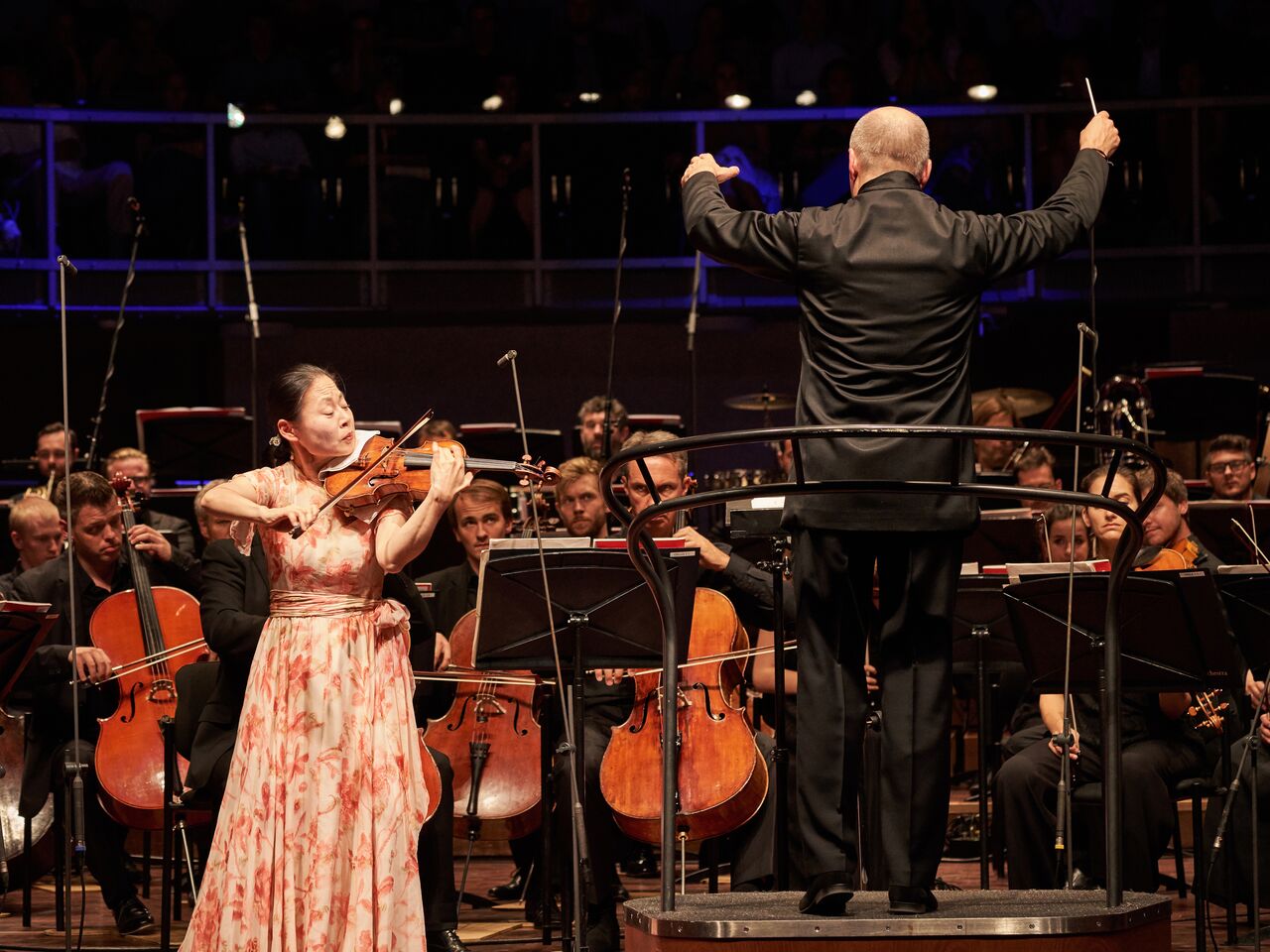 The Estonian component, Erkki-Sven Tüür’s Fireflower, homaged his conductor friend's tenth year in Cincinnati, more than just a fanfare: layered, like Reinvere’s work if more individual, quickly culminating in a percussion-rocking climax that pays homage to the time composer and conductor spent together in a band. Then more Sibelius, the Fifth as you never heard it before: passionately driven but allowing creative space for singing principals like oboist Vegara, having fun but also casting big shadows in the usually intermezzo-like middle movement, sweeping inexorably forward to the ever-surprising ending. Will conductor and players adjust it to the equally unpredictable Albert Hall? We’ll see. But they’re on a roll, and not even the post-show revelling until 4amish on Sunday morning in the leisure nerve-centre of the festival, the Passion Café, should have dented their concentration for tonight.
The Estonian component, Erkki-Sven Tüür’s Fireflower, homaged his conductor friend's tenth year in Cincinnati, more than just a fanfare: layered, like Reinvere’s work if more individual, quickly culminating in a percussion-rocking climax that pays homage to the time composer and conductor spent together in a band. Then more Sibelius, the Fifth as you never heard it before: passionately driven but allowing creative space for singing principals like oboist Vegara, having fun but also casting big shadows in the usually intermezzo-like middle movement, sweeping inexorably forward to the ever-surprising ending. Will conductor and players adjust it to the equally unpredictable Albert Hall? We’ll see. But they’re on a roll, and not even the post-show revelling until 4amish on Sunday morning in the leisure nerve-centre of the festival, the Passion Café, should have dented their concentration for tonight.

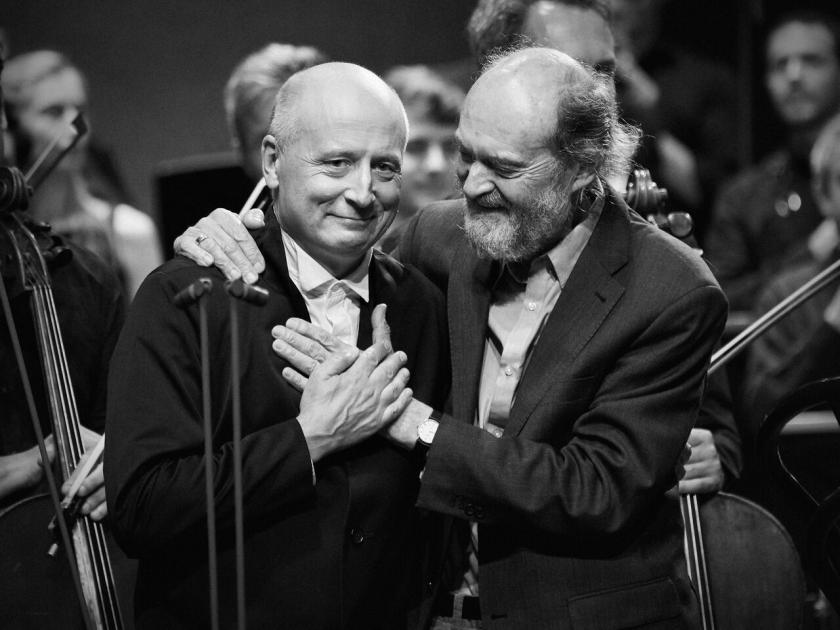













Add comment